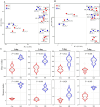The microbiota and metabolome dynamics and their interactions modulate solid-state fermentation process and enhance clean recycling of brewers' spent grain
- PMID: 39328918
- PMCID: PMC11425715
- DOI: 10.3389/fmicb.2024.1438878
The microbiota and metabolome dynamics and their interactions modulate solid-state fermentation process and enhance clean recycling of brewers' spent grain
Abstract
The massive yield of brewers' spent grain (BSG) waste inevitably threaten environmental health. Here, solid-state fermentation (SSF) technology featuring multi-strain (MS) inoculation and high-throughput sequencing technology were employed to facilitate the sustainable and clean recycling of BSG waste while revealing the associated underlying microbiological and metabolic mechanisms. MS inoculation displayed a lower pH value (3.91 vs. 4.12) and neutral detergent fiber content (446.24 vs. 476.23 g/kg DM), a higher levels of lactic acid (86.64 vs. 33.07 g/kg DM), acetic acid (6.13 vs. 4.87 g/kg DM), propionic acid (2.78 vs. 2.18 g/kg DM) and crude protein (307.5 vs. 289.15 g/kg DM) than those in the control group. Moreover, MS inoculation inhibited the formation of non-protein-N and ammonia-N, and spoilage microorganism resuscitation, while enhanced substrate preservation. Microbiologically, during the SSF, the group treated with MS inoculation exhibited an increase in the relative abundance of Leuconostoc (0.58%∼6.60%), Weissella (6.22%∼15.42%), Enterococcus (3.15%∼9.08%), Bacillus (17.63%∼31.29%), Lactobacillus (12.89%∼8.29%), Pseudoalteromonas (12.87%∼16.29%), and a decrease in the relative abundance of Acinetobacter (0.79%∼0.02%) and Enterobacteriaceae (0.78%∼0.24%). Metabolically, starch and sucrose metabolism, arginine and proline metabolism, and phenylalanine metabolism significantly influenced the quality of extruded BSG fermented by MS during SSF. The examination of the correlation between the microbiota, metabolites, and fermentation parameters revealed that complex interactions between microbes and the environment factors impact metabolite production. Collectively, inoculating with MS improved fermentation quality and stability, facilitated the clean recycling of BSG, which is linked to complex interactions among microbes, the environment factors and metabolite production.
Keywords: Brewer’s spent grain waste; environmental factor analysis; metabolome-microbiome interactions; multi-strain inoculation; solidstate fermentation technology.
Copyright © 2024 Xie, Liu, Liu, Tang, Zhao, Chen, Tian, Liu, Cai and Jia.
Conflict of interest statement
The authors declare that the research was conducted in the absence of any commercial or financial relationships that could be construed as a potential conflict of interest.
Figures







Similar articles
-
Brewers' spent grain as substrate for dextran biosynthesis by Leuconostoc pseudomesenteroides DSM20193 and Weissella confusa A16.Microb Cell Fact. 2021 Jan 22;20(1):23. doi: 10.1186/s12934-021-01515-4. Microb Cell Fact. 2021. PMID: 33482833 Free PMC article.
-
Microbial community assembly and chemical dynamics of raw brewers' spent grain during inoculated and spontaneous solid-state fermentation.Waste Manag. 2024 Feb 15;174:518-527. doi: 10.1016/j.wasman.2023.12.021. Epub 2023 Dec 21. Waste Manag. 2024. PMID: 38134539
-
Arabinoxylans Release from Brewers' Spent Grain Using Extrusion and Solid-State Fermentation with Fusarium oxysporum and the Antioxidant Capacity of the Extracts.Foods. 2022 May 13;11(10):1415. doi: 10.3390/foods11101415. Foods. 2022. PMID: 35626985 Free PMC article.
-
Versatile Applications of Brewer's Spent Grain: Solid-State Fermentation and Nutritional Added Value.Appl Biochem Biotechnol. 2024 Aug;196(8):5508-5532. doi: 10.1007/s12010-023-04769-3. Epub 2023 Nov 16. Appl Biochem Biotechnol. 2024. PMID: 37971579 Review.
-
Unlocking the Potential of Brewers' Spent Grain: A Sustainable Model to Use Beer for Better Outcome in Chronic Kidney Disease.J Ren Nutr. 2024 Nov;34(6):482-492. doi: 10.1053/j.jrn.2024.03.007. Epub 2024 Apr 15. J Ren Nutr. 2024. PMID: 38621435 Review.
References
-
- AOAC (1990). Official methods of analysis, 15th Edn. Rockville, MD: Association of Official Analytical Chemists.
LinkOut - more resources
Full Text Sources
Miscellaneous

